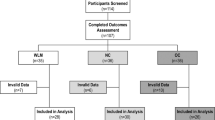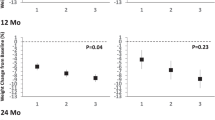Abstract
Objective:
To investigate the effects of a specific program to implement physical activity (fitness program) on weight loss maintenance, activity level and resting energy expenditure (REE).
Design:
Observational study of subjects completing a behavioral program.
Subjects:
In total, 200 overweight/obese subjects (36 males, aged 20–66 years; average BMI, 35.2 kg/m2).
Program and measurements:
The fitness program consisted of 12 bimonthly sessions, chaired by doctors and dietitians, involving groups of 8–12 subjects. Patients entered the program approximately 9 months after the end of behavioral treatment, during a weight loss maintenance period. The goal was set at a light-to-moderate daily physical activity (brisk walking), quantitatively measured by a pedometer; REE was measured before and after the fitness program by indirect calorimetry in a subset of patients.
Results:
The fitness program restarted the process of weight loss in over 60% of subjects. At the end of the study, 84% of patients walked at least 5000 steps per day, compared with 24% at the beginning of the study. The probability of losing from 5 to 10% of initial body weight increased by 20% for any 1000 steps/day (OR, 1.20; 95% CI (confidence interval), 1.07–1.35), and that of losing more than 10% by over 30% (OR, 1.33; 95% CI, 1.19–1.49). REE increased significantly by 100 kcal/day (+7.5%), in spite of further weight loss (−1.8%).
Conclusion:
A specific fitness program in the weight maintenance phase after a behavioral program may significantly improve the long-term control of obesity.
This is a preview of subscription content, access via your institution
Access options
Subscribe to this journal
Receive 12 print issues and online access
$259.00 per year
only $21.58 per issue
Buy this article
- Purchase on Springer Link
- Instant access to full article PDF
Prices may be subject to local taxes which are calculated during checkout


Similar content being viewed by others
References
Hill JO, Wyatt HR, Reed GW, Peters JC . Obesity and the environment: where do we go from here? Science 2003; 299: 853–855.
Wadden TA, Foster GD, Letizia KA, Mullen JL . Long-term effects of dieting on resting metabolic rate in obese outpatients. JAMA 1990; 264: 707–711.
Wyatt HR, Grunwald GK, Seagle HM, Klem ML, McGuire MT, Wing RR et al. Resting energy expenditure in reduced-obese subjects in the National Weight Control Registry. Am J Clin Nutr 1999; 69: 1189–1193.
Wilson GT, Brownell KD . Behavioral treatment for obesity. In: Fairburn CG, Brownell KD (eds). Eating Disorders and Obesity: A Comprehensive Handbook, 2nd edn. The Guilford Press: New York, 2002, pp 524–528.
Leibel RL, Rosenbaum M, Hirsch J . Changes in energy expenditure resulting from altered body weight. N Engl J Med 1995; 332: 621–628.
National Institutes of Health. Clinical guidelines on the identification, evaluation, and treatment of overweight and obesity in adults – the evidence report. Obes Res 1998; 6 (Suppl 2): 51S–209S.
Westerterp KR . Alterations in energy balance with exercise. Am J Clin Nutr 1998; 68: 970S–974S.
Pate RR, Pratt M, Blair SN, Haskell WL, Macera CA, Bouchard C et al. Physical activity and public health. A recommendation from the Centers for Disease Control and Prevention and the American College of Sports Medicine. JAMA 1995; 273: 402–407.
Miller WC, Koceja DM, Hamilton EJ . A meta-analysis of the past 25 years of weight loss research using diet, exercise or diet plus exercise intervention. Int J Obes Relat Metab Disord 1997; 21: 941–947.
Blair SN . Evidence for success of exercise in weight loss and control. Ann Intern Med 1993; 119: 702–706.
Jeffery RW, Wing RR, Sherwood NE, Tate DF . Physical activity and weight loss: does prescribing higher physical activity goals improve outcome? Am J Clin Nutr 2003; 78: 684–689.
Hu G, Lindstrom J, Valle TT, Eriksson JG, Jousilahti P, Silventoinen K et al. Physical activity, body mass index, and risk of type 2 diabetes in patients with normal or impaired glucose regulation. Arch Intern Med 2004; 164: 892–896.
Saris WH, Blair SN, van Baak MA, Eaton SB, Davies PS, Di Pietro L et al. How much physical activity is enough to prevent unhealthy weight gain? Outcome of the IASO 1st Stock Conference and consensus statement. Obes Rev 2003; 4: 101–114.
Pollock ML . Prescribing exercise for fitness and adherence. In: Dishman RK (ed). Exercise Adherence. Human Kinetics: Champaign, IL, 1988, pp 259–277.
Schneider PL, Crouter SE, Bassett DR . Pedometer measures of free-living physical activity: comparison of 13 models. Med Sci Sports Exerc 2004; 36: 331–335.
Tudor-Locke C, Williams JE, Reis JP, Pluto D . Utility of pedometers for assessing physical activity: construct validity. Sports Med 2004; 34: 281–291.
Melchionda N, Besteghi L, Di Domizio S, Pasqui F, Nuccitelli C, Migliorini S et al. Cognitive behavioural therapy for obesity: one-year follow-up in a clinical setting. Eat Weight Disord 2003; 8: 188–193.
Brownell KD . The LEARN Program for Weight Control. American Health: Dallas, 1991.
Expert Panel on Detection Evaluation and Treatment of High Blood Cholesterol in Adults. Executive summary of the third report of the National Cholesterol Education Program (NCEP) expert panel on detection, evaluation, and treatment of high blood cholesterol in adults (Adult Treatment Panel III). JAMA 2001; 285: 2486–2497.
Gormally J, Block S, Daston S, Rardin D . The assessment of binge eating severity among obese persons. Addict Behav 1982; 7: 47–55.
Fairburn CG, Cooper Z . The eating disorder examination (12th Edition). In: Fairburn CG, Wilson GT (eds). Binge Eating. The Guilford Press: New York & London, 1993, pp 317–360.
Fairburn CG, Marcus MD, Wilson GT . Cognitive-behavioral therapy for binge eating and bulimia nervosa. A comprehensive treatment manual. In: Fairburn CG, Wilson GT (eds). Binge Eating: Nature, Assessment and Treatment. The Guildford Press: New York, 1993, pp 361–404.
U.S. Preventive Services Task Force. Behavioral counseling in primary care to promote physical activity: recommendation and rationale. Ann Intern Med 2002; 137: 205–207.
Guidelines Subcommittee. 1999 World Health Organization–International Society of Hypertension Guidelines for the Management of Hypertension. J Hypertens 1999; 17: 151–183.
Duncan DB . Multiple range test for correlated and heteroscedastic means. Biometrics 1957; 13: 164–204.
LaMonte MJ, Barlow CE, Jurca R, Kampert JB, Church TS, Blair SN . Cardiorespiratory fitness is inversely associated with the incidence of metabolic syndrome. A prospective study of men and women. Circulation 2005; 112: 505–512.
Laaksonen DE, Niskanen L, Lakka HM, Lakka TA, Uusitupa M . Epidemiology and treatment of the metabolic syndrome. Ann Med 2004; 36: 332–346.
Eden KB, Orleans CT, Mulrow CD, Pender NJ, Teutsch SM . Does counseling by clinicians improve physical activity? A summary of the evidence for the U.S. Preventive Services Task Force. Ann Intern Med 2002; 137: 208–215.
Prochaska JO, Velicer WF . The transtheoretical model of health behavior change. Am J Health Promot 1997; 12: 38–48.
Cooper Z, Fairburn CG, Hawker DM . Cognitive-Behavioral Treatment of Obesity. The Guilford Press: New York, 2003.
Sequeira MM, Rickenbach M, Wietlisbach V, Tullen B, Schutz Y . Physical activity assessment using a pedometer and its comparison with a questionnaire in a large population survey. Am J Epidemiol 1995; 142: 989–999.
Kashiwazaki H, Inaoka T, Suzuki T, Kondo Y . Correlations of pedometer readings with energy expenditure in workers during free-living daily activities. Eur J Appl Physiol Occup Physiol 1986; 54: 585–590.
Bassett Jr DR, Ainsworth BE, Leggett SR, Mathien CA, Main JA, Hunter DC ; et al. Accuracy of five electronic pedometers for measuring distance walked. Med Sci Sports Exerc 1996; 28: 1071–1077.
Melanson EL, Knoll JR, Bell ML, Donahoo WT, Hill JO, Nysse LJ et al. Commercially available pedometers: considerations for accurate step counting. Prev Med 2004; 39: 361–368.
Jakicic JM, Winters C, Lang W, Wing RR . Effects of intermittent exercise and use of home exercise equipment on adherence, weight loss, and fitness in overweight women: a randomized trial. JAMA 1999; 282: 1554–1560.
Fogelholm M, Kukkonen-Harjula K . Does physical activity prevent weight gain – a systematic review. Obes Rev 2000; 1: 95–111.
Poehlman ET, Melby CL, Badylak SF, Calles J . Aerobic fitness and resting energy expenditure in young adult males. Metabolism 1989; 38: 85–90.
Burke CM, Bullough RC, Melby CL . Resting metabolic rate and postprandial thermogenesis by level of aerobic fitness in young women. Eur J Clin Nutr 1993; 47: 575–585.
Broeder CE, Burrhus KA, Svanevik LS, Wilmore JH . The effects of either high-intensity resistance or endurance training on resting metabolic rate. Am J Clin Nutr 1992; 55: 802–810.
Broeder CE, Burrhus KA, Svanevik LS, Wilmore JH . The effects of aerobic fitness on resting metabolic rate. Am J Clin Nutr 1992; 55: 795–801.
Melby C, Scholl C, Edwards G, Bullough R . Effect of acute resistance exercise on postexercise energy expenditure and resting metabolic rate. J Appl Physiol 1993; 75: 1847–1853.
Ballor DL, Poehlman ET . Exercise-training enhances fat-free mass preservation during diet-induced weight loss: a meta-analytical finding. Int J Obes Relat Metab Disord 1994; 18: 35–40.
Dalle Grave R, Melchionda N, Calugi S, Centis E, Tufano A, Fatati G et al. Continuous care in the treatment of obesity. An observational multicentre study. J Intern Med 2005; 258: 265–273.
Perri MG, Sears Jr SF, Clark JE . Strategies for improving maintenance of weight loss. Toward a continuous care model of obesity management. Diabetes Care 1993; 16: 200–209.
Author information
Authors and Affiliations
Corresponding author
Rights and permissions
About this article
Cite this article
Villanova, N., Pasqui, F., Burzacchini, S. et al. A physical activity program to reinforce weight maintenance following a behavior program in overweight/obese subjects. Int J Obes 30, 697–703 (2006). https://doi.org/10.1038/sj.ijo.0803185
Received:
Revised:
Accepted:
Published:
Issue Date:
DOI: https://doi.org/10.1038/sj.ijo.0803185
Keywords
This article is cited by
-
Cognitive-Behavioral Treatment of Nonalcoholic Fatty Liver Disease: A Propensity Score-Adjusted Observational Study
Obesity (2011)
-
Physical Activity After Surgery for Severe Obesity: The Role of Exercise Cognitions
Obesity Surgery (2011)
-
Physical Activity Patterns During Weight Maintenance Following a Low-energy Density Dietary Intervention*
Obesity (2007)



